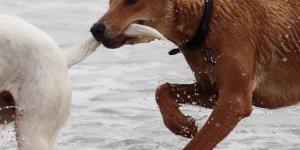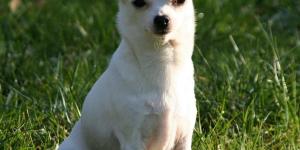German Shorthaired Pointer

German shorthaired pointers are multifunctional hunting dogs. They are able to perform tasks such as collection and tracking. That is why they are very popular among hunters.
Despite a somewhat unknown origin, we do known they are very intelligent and loyal dogs. This breed needs a large dose of daily physical activity and aren’t suited to living in small spaces such as apartments or small houses. They are very playful and sociable, with children and other pets. If you are thinking of adopting a German Shorthaired pointer, this AnimalWised breed file will tell you everything you need to know about this lovely breed.
- Europe
- Germany
- Group VII
- 5-14
- 14-18
- 18-22
- 22-27
- 27-31
- More than 31
- 2-7
- 7-22
- 22-55
- 55-100
- 100-220
- 8-10
- 10-12
- 12-14
- 15-20
- Low
- Meidum
- High
Origin of a German Shorthaird Pointer
The history of this breed of hunting dogs is vague and somewhat confusing. It is believed that this breed carries the blood of both Spanish and English pointers, as well as other breeds of hunting dogs. This genealogy however is not certain. The only thing that is clear, is that this breed is collected in the book of the origins of the German shorthaired pointer or "Zuchtbuch Deutsch-Kurzhaar". This book is a document which was formed by Prince Albrecht de Solms-Braunfels to establish the characteristics of this breed, the rules of the trial of morphology and the basic rules of work tests for hunting dogs.
The breed was, and still is, very popular among the hunters of his home country, Germany. They are not as popular in other countries.
Physical Appearance
According to the FCI standard of this breed, the height at the withers ranges from 62 to 66 centimeters for males and 58 to 66 centimeters for females. The ideal weight is not indicated , but short-haired German pointers usually weigh around 25 to 30 kilograms. This pointeris a tall, muscular and strong dog, but it is not heavy or rough.In fact, it is a beautiful and well-proportioned animal. Their backs are strong and well muscled, with a short, muscular and straight or slightly arched back. The rump, broad and muscular, leans only slightly towards its tail. Its chest is deep and its bottom line rises slightly to the height of the belly.
Its head is long and noble looking and it carrier brown and dark eyes. Its ears hang on the sides of its head and are slightly bent forward. Its skull is broad and slightly domed, while its naso-frontal depression is moderately developed. It has a long, wide and deep snout. Its eyes are medium-sized and are commonly brown. Its ears are smooth, medium-sized with a high insertion. They hang on the sides of its cheeks and have rounded tips.
Its tail is of high insertion and is carried horizontally. Unfortunately, both the breed standard accepted by the International Cynological Federation (FCI) and the breed standards of other organizations indicate that the tail should be amputated approximately in half of the countries where such activity is allowed.
Its coat covers its entire body and is short, tight, rough and hard to the touch. It can appear solid brown, brown with small white spots, brown roan, white with brown head, black or black roan.
Character
The hunting nature of this pointer defines its temperament. This is an active, lively, curious and intelligent dog that enjoys outdoor activities and the company of its family. If you have adequate space and enough time to dedicate to this breed, they can become excellent pets for dynamic people and families who enjoy outdoor activities. These pointers are not good pets for people or sedentary families who live in apartments or small houses.
If socialized from an early age, the German shorthaired pointer will be a friendly dog, both with strangers, dogs and other animals. In these conditions it is usually very friendly and playful with children. On the other hand, if it is going to live with small pets, socialization needs to be taken seriously from when it is a puppy. If these dogs are not properly socialized their hunting instincts may emerge when they are adults. .
Their great dynamism and strong hunting instincts often cause behavior problems when these dogs are forced to live in apartments or densely populated areas as they cannot expel their their energy. In these cases, dogs can tend to be destructive and conflicting. In addition, short-haired German pointers are often noisy animals, and bark frequently.
Caring for a German Shorthaired Pointer
Although the German shorthaired pointer loses hair regularly, the care of its coat is simple and does not require great effort or time. Regular brushing every two or three days to keep the hair in good condition is sufficient. If the dog is hunting, it may be necessary to brush it more often to remove dirt .You only have to bathe these dogs when they are dirty.
These dogs need to be constantly accompanied and require a lot of physical and mental exercise. This is one of the reasons they do not adapt very well to life in apartments or densely populated cities. The ideal situation is for these pointers to live in a house with a large garden or in a rural area where they can run with greater freedom. These dogs need to be walked daily for exercise and socialization purposes.
Education and Training
It is easy to train these dogs for hunting, as it is instinctual. However, when it comes to training necessary for a pet it can prove to be a little more difficult. This is due to the fact that this breed are easily distracted. Even so, they are intelligent and can become excellent pets if they are educated through positive training. Traditional training does not work well with this breed, therefore we encourage using positive reinforcement.
Health
This is one of the healthiest dog breeds, but naturally it is still prone to diseases common to other large breeds. Among these diseases are:
- hip dysplasia
- entropion
- gastric torsion
- progressive retinal atrophy
- lymphatic obstruction
- ear infections
German Shorthaired Pointer photos
























